
Stage Four - New Promise in Nomansland - but British Colonial Government Annex their land
Image right: Map of East Griqualand just before
the Griquas moved in
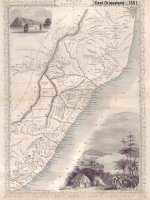
 |
||
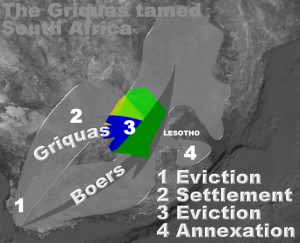 |
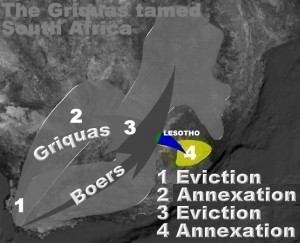 |
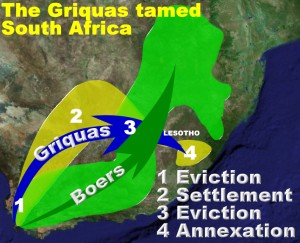 |
Previous Page |
The history of the Griquas in a Map (click) |
Next Page |
Nomansland's Origins:It is worth describing the absolute extermination of these black tribes in this region by Chaka's men who claimed their livestock as their bounty. The Zulu impis cleared the land between the Drakensberg (Zulu name Quathlamba or "The Barrier of Spears") to the west and sea to the east extending from Chakas kraal in the north as far south as Port St John a beautiful spot on the Indian Ocean about 50 miles south of Kokstad. The Fingoes, a mixed tribal group living in East Griqualand, get their name from the cries of the various stragglers that survived and ran before the Zulu onslaught. Their plaintive cry to the kraals they came upon as they fled south was "Fengusa"... we are in want. The death march of Chaka's Impis was not stopped by these fleeing tribes but by the inclement weather. Chaka would not allow his impis to wear anything but a loin cloth - hardly satisfactory clothing in cold weather. The night before Chaka's impis raided a Baca kraal below Mount Ayliff the weather turned extremely cold, snow and rain fell and the inadequately clad crack footsoldiers perished in their hundreds on the unprotected slopes of the Insizwa those who survived the night were frozen and could hardly move. The Baca, sensibly clothed, were able to easily route and slaughter most of the remaining Zulu warriors - only a handful escaping back to Chaka's kraal. Insizwa gets it name from this historical event, it is the native name for "Mountain of Salvation". The video clip on the right by Scott Balson uses Google Earth to show the remarkable and dangerous trek undertaken by the Griqua over the Ongeluksnek Pass (use full screen for best results) The British Governor in the Cape, Sir George Grey, granted the Griquas sovereignty of this devastated region some forty years later - but, once again, the multiracial Griqua people had been used. Their role was, de facto, to pacify the warring native tribes, saving the British that expense. Once the Griquas had achieved that goal the land was annexed. |
While many Griquas remained around Philippolis, living today at the small settlement of Bergmanshoogte most decided to follow their Kaptyn Adam Kok III and take the perilous journey across the Drakensberg to NOMANSLAND about 200km, as the bird flies, to the east.

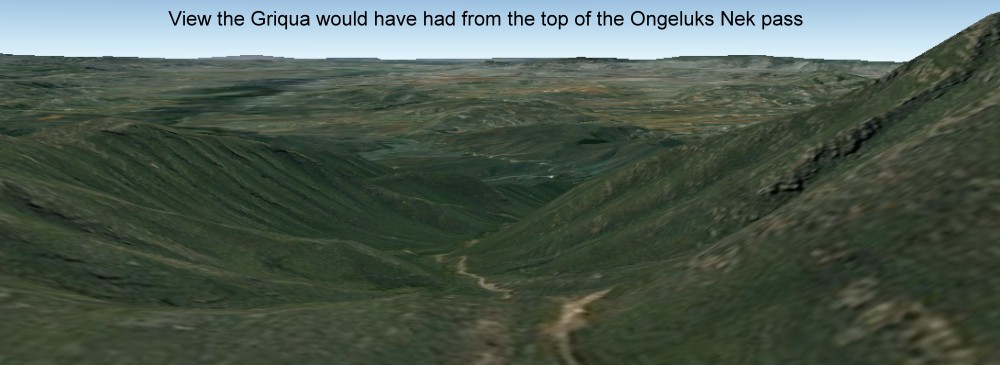
To get there they first moved to Hanglip (now known as Mohales Hoek) in Basutoland (now Lesotho) for a few years before travelling down the now infamous Ongeluksnek pass to what is today known as Matatiele. While at Hanglip Basuto bandits raided their livestock and rode off on their horses. Ironically they were only 100 kilometres from their destination - but the route they had taken was impassable.
They lost nearly all their estimated 30,000 head of cattle after travelling through Basutoland, across the Drakensberg (Quathlamba or "TheBarrier of Spears") and down the small and dangerous mountain track, the Ongeluksnek (named after their trek and literally meaning accident pass). The actual path taken by the Griquas down the deadly Ongeluk's Nek Pass can be seen by viewing the video clip above.
Scott Balson's 2007 visit to the Ongeluks Nek (with hundreds of photos) at this link

The majestic but deadly Ongeluksnek in the Drakensberg
They literally had to build the road across parts of Basutoland to the pass
and then rebuild their 360 wagons many times as the only way they could get
the unwieldly vehicles down some parts of the pass was by lowering them
in pieces down steep declines into NO MAN'S LAND.
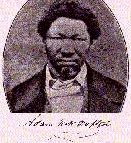
Image right: Adam Kok, leader of the Griquas at Nomansland
By the time they reached the area on the slopes of Mount Currie, in central NOMANSLAND, in 1863 the Griquas under Adam Kok were but a shadow of their former glory and were financially ruined. Mount Currie was named after Sir Walter Currie - picture at this link
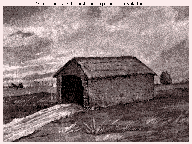 In
A F Hatterlay's LATER
ANNALS OF NATAL records he states on page 23 when quoting from the journal of a prospecting company.
This very important reference relates to the Griqua settlement at Mount Currie on 22nd July 1867 (ie pre-Kokstad). The source is the Journal of the Umzimvubu Prospecting Company's Expedition to Nomansland and Amapondoland:
In
A F Hatterlay's LATER
ANNALS OF NATAL records he states on page 23 when quoting from the journal of a prospecting company.
This very important reference relates to the Griqua settlement at Mount Currie on 22nd July 1867 (ie pre-Kokstad). The source is the Journal of the Umzimvubu Prospecting Company's Expedition to Nomansland and Amapondoland:
"To our disgust and disappointment we found it (the laager at Mount Currie) a very dirty place, consisting of about 200 mudhuts, a few old waggons, and a lot of dirty Griquas, sitting or lying outside their dens. A small church and a fort in the middle of the village and Adam Kok's house at one end. While we were in the store, one of Adam's daughters (or rather the "Princess Royal") came to purchase a bar of soap, and she certainly looked as though the money was well invested. Adding to the miserable appearance of the laager a number of houses half built and allowed to remain with their four walls standing. It is indeed, as one of our party called it, a village in ruins before it was built. After visiting a few stores and purchasing some necessary things for our larder, we passed through this wretched village and outspanned about four miles on the high road to Grahamstown.."
In 2009 Scott Balson discovered the foundations of the historic Griqua Mount Currie settlement using Google Earth. This fascinating story can be followed at this link.
"It is, indeed, as one of our party called it, a
village in ruins before it was built."
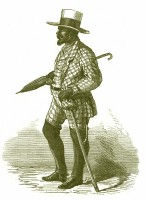
Just four years after arriving in Nomansland Captain Adam Kok ceded his land to Natal in a ceremony held at the Umtampura River in 1867 and attended by his Excellency Colonel Bisset. Kok did so as a last resort because he needed help in removing small bands of raiding Pondos who were continually stealing his people's livestock.
The Griqua chief's attempts to parrot the white man can be seen in his attire at this ceremony (see image right). He was described as wearing, a green tartan suit, with sword and umbrella, a large hat and black leggings. The original portrait was drawn by Lieutenant H K Wilson of the 96th Regiment in Natal who attended the ceremony. (See also "The Illustrated London News" 28th December 1867, page 704)
The move by Kok to cede to Natal was not a popular one and Natal took no action in possessing the isolated new territory with its native troubles. It had internal troubles of its won with the war-like Zulus to the north stretching its resources. It was the Cape Colony some years later that snapped up Nomansland - claiming it as their own. This move, because of the earlier agreement Natal had with Kok, caused quite a fall-out between the British Governors of the Cape and Natal at that time.
Image right: Kokstad as at July 1877
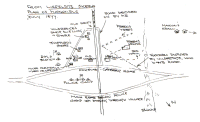 In 1869 the site of the present day Kokstad was selected by a delegation
of prominent citizens including the Rev William Dower. A stick planted in
an ants nest marking the spot that is today the city's centre.
In 1869 the site of the present day Kokstad was selected by a delegation
of prominent citizens including the Rev William Dower. A stick planted in
an ants nest marking the spot that is today the city's centre.
Despite the best efforts of Adam Kok and their Minister the Griquas refused to move from their old Laager - until a particularly cold winter's night in 1872 after which Kok proclaimed that the Kaptyns must follow him to the new town, as it was then known.
They did and Kokstad slowly evolved into a town many called "sod city", once again the Griquas sold their free erven far too cheaply and were soon landless.
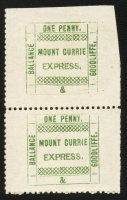 The traders in NO MANS LAND viewed
the Griquas arrival with approval. Mr Scott, a trader, wrote "Whatever
faults the Griquas had, they one good quality for traders; they would buy
anything."
The traders in NO MANS LAND viewed
the Griquas arrival with approval. Mr Scott, a trader, wrote "Whatever
faults the Griquas had, they one good quality for traders; they would buy
anything."
Dower in his book "The Early Annals of Kokstad and East Griqualand" puts this "buying mania" down to the fact that (before 1876) "they had been deprived of their accustomed pleasure of handling money. Now, when (Strachan and Co) money was obtainable (in exchange) for land they could not be persuaded to resist the temptation of merely handling the cash."
Image right: One of the world's rarest stamps - the Mount Currie Express one penny (1874) less than 50 exist - this pair - one of only two known - are in the Balson Holdings Family Trust collection. More at this link.
The administration of NO MAN'S LAND was handed over to Adam Kok by the British
Governors in the Cape and Natal. Kok set about rebuilding his nation with
the help of a few local traders headed by George Brisley who would become
a partner in the Strachan and Co trading empire.
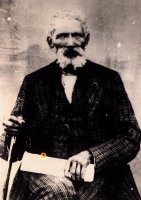 |
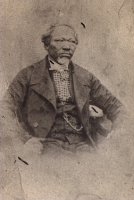 |
|
Nikolaas Waterboer |
Hendrick Hendricks |
Adam Kok III |
| The manner in which the Griqua
Raad (government) made decisions is best described in the Rev Dower's book
"The Early Annals
of Kokstad and East Griqualand":
Image right: Site of the Griqua Settlement on Mt Currie above Kokstad Old Piet Draai made frequent visits to the kitchen to light his pipe. He was admitted to be the best judge of the earliest moment when the beef was eatable. When Piet's voice was heard proclaiming the joyful news "Kerls de kos is gaar" (Gentlemen the beef is cooked) the House rose with a stampede. These Griqua Parliamentary dinners were held much after the primitive fashion which obtained in England in the days of good King Alfred. The simplicity of manners saved the little State manifold needless costs in the way of crockery, cutlery and napery. The form of Government was roughly on the lines of the British Constitution. Imitation of the white man was the unacknowledged, although the real rule of procedure. "De Engelsche maken zoo", (The English act so). Beyond that there was no appeal. He goes on to record: "The Volksraad was a wonderful anachronism. Its sittings were held half yearly, and lasted as long as the commissariat held out. It was very free and easy both as to its composition and conduct of business. Very little real business was done, and very imperfect accounts of its proceedings were kept. After a session was over it was no uncommon occurrence for discussion to arise as to what had been decided." |
1872 map of South Africa demonstrates colonial deception over land ownership at this key time
From the very start the Griqua leader Adam Kok asked Donald Strachan, the
region's most successful trader, to play a major role in the development
of the Griqua nation in the land that was now called Griqualand East. Donald
Strachan soon commanded the respect and affection of the Griquas as well
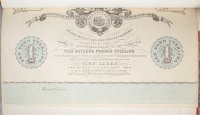 as the local African tribes and
Kok asked him to
act as their
Magistrate in Umzimkulu.
as the local African tribes and
Kok asked him to
act as their
Magistrate in Umzimkulu.
Under the extraordinary circumstances described by Dower (above) the Griqua Parliament or Raad voted, at great expense, to print its own one pound bank note not long after the cession of East Griqualand to Natal had failed to ease their internal problems with the marauding Pondos. At this time the Durban Bank in Durban, Natal had issued its own bank notes - this could have been the catalyst behind their thinking. It was Strachan's timely advice that stopped Kok issuing some 10,000 one pound notes in 1868. Like the flawed thinking that Griqua Town coins circulated in 1815 their proposed bank note had no government asset or gold standard on which to base its circulation or value and would have been a disaster if introduced.
Almost all the bank notes were destroyed - those that remain are bound into the extremely rare book by Rev W Dower, "The Early Annals of Kokstad"..
The Strachan and Co trade tokens - currency in East Griqualand
Strachan and Brisley, the partners in Strachan and Co, did promise Kok that he would investigate alternative ways of getting around the problems associated with the Griqua's isolation from banks and the resulting dependence on the highly unsatisfactory system of bartering goods. Their answer was to issue their own coinage in 1874 which immediately became the currency of the people in the Nomansland region for over 50 years. This ambitious project took a few years to complete, with four brass coins being minted in Germany.
The Strachan and Co trade tokens were accepted as bona-fide currency everywhere throughout Nomansland, including banks, shops, Church collections and government agencies and are today recognised as the first indigenous South African currency.

Griqualand West
For those Griquas who had remained in Griqualand West things came unstuck in the 1870s when diamonds were found at Kimberley and whiteman's greed set in - the territory was annexed to the Cape. Central to this was the discovery of the little known "Natalie Star" a rough, flawless, primrose coloured diamond weighing 350 carats named by Barney Blitz after his lover, a Griqua woman (Natalia Marneweck), whom he called "Mooi Klip" (pretty stone). (Source "Solitaire" by Graham Masterton published 1982).
More than anything else it was the Griquas lack of understanding of land title that led to their demise as a nation "ontze nasie".
Listed below is one of several unique and extremely valuable land titles from East Griqualand held by the Balson Holdings Family Trust:
Property, Riet Fontein, purchased by George Charles Brisley 1st July 1879 - East Griqualand
This Grant to Brisley on perpetual quitrent was authorised at Cape Town on 1st July 1879 and carries the official embossed "Public seal of the settlement at Cape Town". The Grant (full document on right) is signed by the Governor and High Commissioner, Sir Henry Bartle Frere and by the Commissioner of Crown Lands. The deed is for the farm "Rietfontein" which measures 1295 morgen in extent in the Mount Currie (Kokstad) district of East Griqualand. The deed has three revenue stamps, four pound, twelve shilling and three penny. The document is owned by the Balson Holdings Family Trust.
Brisley was the official who announced in 1872 that the name of the capital
of East Griqualand would be
"Kokstad". Images below: key parts of the original land grant to Charles Brisley |
Details of the other land titles held by the Balson Holdings Family Trust can be seen at this link.
Several traders including Donald Strachan used loans, which the Griqua had
no understanding of, to gain their farms through what would be through an
illegal fashion today. Non repayments of the loans for small amounts would
result in default and the farms would then be legally claimed by the trader.
James Cole acquired phenomenal wealth and land ownership through this unfair
process.
| Lot number | Date Acquired | Farm Name | Griqua Landowner |
| 244 | ? | Entshona | ? |
| 274 | 16/6/1874 | Donkerpoort | Adam Kok |
| 283 | 14/12/1872 | Balule | ? |
| 284 | 14/12/1872 | Nqozan | ? |
| B13 | 7/3/1884 | Uzane | Piet Kars |
| C68 | 28/11/1884 | Umhlonga | Jacob Gertze |
| C62 | 6/12/1884 | Julwa | Smit Pommer |
| 22/1/1885 | Umyembe | M de Bruin and J Etchelle | |
| C106 | 30/4/1885 | Boboi | Gert Ruiters |
| A281 | 7/3/1888 | Amsterdam | W van Wyhe |
| 7/3/1888 | Maka | Jacob Kars | |
| B29 | 17/3/1888 | Ulaka | Jacob Lodewyk |
| 17/3/1888 | Niewjaarsfontien | Nicholas Samson |
Image right: Kokstad today - the road leading into
the
town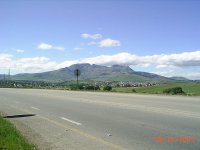
In 1874 the Cape Colonial Government through the appointment of a newly elected British Resident, Joseph Orpen, set out to annex East Griqualand - much to the displeasure of all its inhabitants - white settlers, Griqua and natives alike. Adam Kok remarked at a public meeting in which Orpen set out the terms of annexure, "There you have it... we were not consulted. We can say nothing." Part of the annexation process included determining the legitimacy of all land grants made by the Griquas under Kok - an issue which created much anger amongst the wider community. To make matters much much worse, the well respected Kaptyn, Adam Kok, the Griqua's last recognised leader in East Griqualand, died unexpectedly not long after on the 30th December 1875. This happened while travelling with his family from Kokstad to Umzimkulu to attend a New Year celebration organised by Donald Strachan to divert attention from the travesty of occupation by the Cape. Kok, while leaning across the front of his carriage to whip his horses, fell out over the front and was killed when one of the wagon's wheels went over him crushing his chest.
Captain Blythe arrived in Kokstad in early 1876 and proclaimed that in light of the Kaptyn's death he was now the Chief Magistrate and ruler of the territory. He read out his own commission of appointment while Donald Strachan translated his words into Dutch. A growing mood of despair and anger spread through the assembled Griquas, Blythe's disbanding of the Volksraad or Committee of Twelve which he claimed were trouble makers and his arrogance typified by his statement "I did not desire to come here but I was ordered to come. I have been a soldier of the Queen, and intend to obey. So must you."
The view expressed by the Griquas was that they had been "taken over like cattle or sheep".
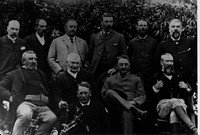 During the next few years a high
degree of political instability shook East Griqualand. This was further
aggravated by Griquas selling their land cheaply to European settlers - the
Griquas had literally given away their valuable land holdings (rural farms
and plots in Kokstad) in exchange for food, or worse, a bottle of brandy.
Eventually in 1878 the British decided to formalise their control of the
territory that they had earlier given to the Griquas. This was a move that
led to the Griqua rebellion. In 1879, following their defeat by the British
the Griqua nation was disbanded and the territory incorporated into the Cape
Colony, as mentioned earlier, much to the chagrin of the Governor of Natal.
During the next few years a high
degree of political instability shook East Griqualand. This was further
aggravated by Griquas selling their land cheaply to European settlers - the
Griquas had literally given away their valuable land holdings (rural farms
and plots in Kokstad) in exchange for food, or worse, a bottle of brandy.
Eventually in 1878 the British decided to formalise their control of the
territory that they had earlier given to the Griquas. This was a move that
led to the Griqua rebellion. In 1879, following their defeat by the British
the Griqua nation was disbanded and the territory incorporated into the Cape
Colony, as mentioned earlier, much to the chagrin of the Governor of Natal.
Image right: Taken at Brook's Nek at the annexation of Pondoland by the British in 1894. Standing L-R: Guy White; A H Williams; C Woodroffe; Middleton; Hugh Nourse; Capt Wynous. Seated L-R: Donald Strachan; John Scott; Cecil Rhodes; Major DB Hook (FAMP) - see Major Hook's book "With Sword and Statute" at this link, Front: E H Hogge (Resident Magistrate Matatiele)
Strachan's private multiracial army, the "Abalandalozi", or preservers, keepers, caretakers, protectors, played a major role at this time in squashing minor native rebellions in the region - especially with the Pondolisi from 1868 to the late 1800s. Theal records in his "History of South Africa V" page 198 "These people consisted principally of little groups of refugees who had lost their hereditary chiefs, and who had settled in Umzimkulu under Mr Donald Strachan's protection when he was one of Adam Kok's Magistrates. Since that time they have regarded him as their head, and were devoted to him personally. Mr Strachan had resigned the appointment of Magistrate of Umzimkulu, but at Mr Brownlee's request he now became the commander of the auxiliary Bantu forces, and was followed to the field by quite a formidable though undisciplined army."
The Abalandalozi were distinguished by guineafowl feathers which they wore in their hatbands but their rag-tag appearance and multi-racial make up did not sit well with some - they were often referred to in reports as "Strachan's Wild Mountaineers". For example, Mrs E C Coetser, a member of an Afrikaner family who settled at Cedarville, noted when they fled to Kokstad at the start of the "Gun War" in 1880: "Strachan het al die lojale kaffers opgeroep... Honderde lojale bongeverfde kaffers (Baccas) het die dorp... ingekom, gesing, geskree en geslaan op hulle skildevelle wat 'n mens senuweeagtig gemaak het... Die kaffers was tien teen een witman." (Translated: "Strachan called all the local blacks, hundreds of loyal armed Baccas entered the town (Kokstad) singing, shouting and hitting their shields making a person very nervous as there were ten blacks to every white."
Interestingly Dower shared her concerns saying in part on page 112 of "The Early Annals of Kokstad and East Griqualand", They entered Kokstad several hundred at a time. They came along singing their war song, beating their shields all in rhythmic time making a weird, and to unaccustomed ears, a terrible sound. More than once I felt not a little nervous when these fierce armed and mounted men, with the frenzo of war upon them - some in full war paint - stood two deep round the Market Square.
At this time Donald Strachan's voluntary army boasted 3,000 men. (Source: No Mans Land - Griqualand by Ken Strachan.)
See also this link for more on the Abalandalozi
At this time Stanford, the Chief Magistrate of East Griqualand noted:
(pg 85) I left Strachan in Pondoland to supervise the work in connection with the road and generally to represent me for the time being with the Pondos.
(pg 105) Simon Rhadebe (the African headman who had raised Donald Strachan) advised Strachan that following the death of the Pondo Chief Umqikela's that he had been "smelt out" as the person causing his death and was under great threat. Strachan withdrew from Pondoland feeling that the Government with which he had been in direct communication did not give him the material support which he though necessary under the circumstances. Mr Strachan brought away with him the road inspector and the small detachment of C.M.R. under Lieutenant Woon which had accompanied him into Pondoland. Thus the work of road construction came to a sudden stop.
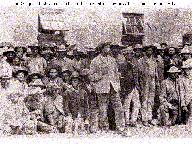 In 1897 and 1898 a few of the Griquas, unhappy at their plight, threatened
to rise up against the British. Their leader Andrew Andries Stockenstrom
Le Fleur and were arrested.
In 1897 and 1898 a few of the Griquas, unhappy at their plight, threatened
to rise up against the British. Their leader Andrew Andries Stockenstrom
Le Fleur and were arrested.
Image left: Le Fleur and his followers outside the Kokstad Magistrates Court in 1898 after handing themselves over to the British authorities
History records that they were rounded up by Donald Strachan and his army, the Abalandolosi, before they could do any damage but the Griqua people have a very different view on this:
By January 1897 Le Fleur's (the Reformer) attempts at reclaiming land had led to a perception that he was an agitator and he was arrested on a charge of inciting rebellion. A preliminary examination took place in March 1897. He was kept in jail until he could be tried at the circuit court in Umtata in October 1897, when he was acquitted.
When, after some time, no response was received from the Cape Colonial Government on the land claims, The Reformer called together 50 Griqua burghers at a place by the name of Driekop near Kokstad to discuss the issue. The Government had by now declared him an outlaw and offered a reward of £500 for his capture - dead or alive. A skirmish took place between The Reformer's people and the Cape Mountain Rifles at Driekop. The burghers had to defend themselves armed only with quince sticks, but came off unscathed and even managed to capture some of the soldiers. The Reformer advised his followers not to use further violence and the group went to the magistrate's office at Kokstad and handed themselves over. The Reformer was tried at Kokstad in April 1898 on a charge of attempting to wage war. He was found guilty of high treason on 29 April 1898 and sentenced to 14 years hard labour at the Breakwater Prison in Cape Town.
Today, a century later, his descendants including magistrate Andrew Le Fleur are still active in the Griqua and Khoisan revival movements.
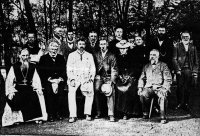 Image
right: Meeting of the authorities of East Griqualand at Lourdes deliberating
about the defence of Lourdes during the 1898 Griqua "rebellion".
Image
right: Meeting of the authorities of East Griqualand at Lourdes deliberating
about the defence of Lourdes during the 1898 Griqua "rebellion".
Seated from left to right: Abbott Francis Pfanner of Emaus Mission; J.H. Scott Chief Magistrate of East Griqualand; The Hon W P Schreiner Prime Minister Cape Colony; W E Stanford Superintendent Native Affairs Cape Colony; Miss Windus; Captain E O Windus Resident Magistrate Umzimkulu
Standing from left to right: Trappist Father Joseph Biegner; W G Cummin Resident Magistrate Kokstad; E E Dower Private Secretary; Donald Strachan (trader and leader of the Abalandalozi); Rev Fr H Howlett priest in charge of St Patrick's Mission Kokstad; Brother Nivard Streicher Trappist; A F Payne, James Cole
Enrolling troops in Griquatown
An interesting postscript to the Griqua's allegiance with the British despite being let down so badly so often by them occured in 1899.
The Illustrated London News reports on 30th December 1899 (page 956):
From Griquatown come two photos which have especial interest in connection with the Boer raid reported in that quarter from Hopetown on Nov 28. It appears that one hundred Boers entered the town, and robbed the police station there. Inspector Guillond, who was in command, was imprisoned for removing the breech-blocks from the Government rifles. Griquatown is in the district of Hay, Cape Colony.
| Public buildings in Griquatown in 1899 | Enrolling farmers as special police at Griquatown after the Boer raid |
| How the Boer War affected Griquatown:
On 12 August 1901 marauding boers tried to drive off about 800 horses grazing under guard of Cpl Mathieson and 6 men about 5km from the camp (Griquatown). Pte IJ O’Neil was mortally wounded in the resultant firing, and Pte G. Jones was also hit in the hand, but Lt-Col. Woodhead, Lt JC Berrange and the mounted men galloped out and clashed with the enemy rearguard about 3km from the village. The boers were thus driven off, but unfortunately got away with the horses. Twelve days later a convoy bound for Griquatown was attacked at Rooikoppies, but the enemy were driven off after a stiff fight in which the Imperial Yeomanry lost 8 killed and 23 wounded. The Dukes, who had provided 26 mounted men and 11 infantry of the escort, had no casualties, and the convoy reached its destination safely next day. Within little over a week, however, Griquatown itself was being threatened by a strong enemy force. On Lt-Col. Woodhead’s instructions, a patrol of 20 mounted infantry under Lt JC Berrange attacked the enemy at Moosfontein on 6 September and temporarily relieved the pressure on the garrison by driving the boers off |
In 1976 East Griqualand was made an independent homeland called Transkei by the National Party. Following the transfer of power to the blacks under the ANC the Transkei was once again incorporated into South Africa.
When the Transkei homeland was created the historic role of the Griqua in this region was totally overlooked with the constitution not recognising Coloureds (Griqua), the original owners of the land, as being able to become citizens in their own territory..
Here is the relevant extract: In terms of the constitution, Transkeian citizenship would be open to Africans only, excluding the Coloureds and Whites living permanently in the territory.